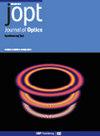Microstructured flexible polymer films with embedded phosphor for multifunctional passive radiative cooling
IF 2.7
4区 物理与天体物理
Q3 OPTICS
引用次数: 0
Abstract
Passive daytime radiative cooling schemes are of much interest because of their attractive potential to reduce energy consumption. However, the structural conditions for designing and fabricating efficient radiative cooler limit their optical diversity and hinder their practical utilization (用于多功能被动辐射冷却的嵌入荧光粉的微结构柔性聚合物薄膜
日间被动辐射冷却方案因其在降低能耗方面的巨大潜力而备受关注。然而,设计和制造高效辐射冷却器的结构条件限制了其光学多样性,阻碍了其实际应用(如发光冷却面板、智能窗户系统、智能招牌或防伪)。本文通过在辐射聚合物层中同时加入斑点图像全息无序微结构和荧光粉颗粒,展示了多功能被动辐射冷却薄膜。所获得的多功能薄膜在日光区域具有较高的全反射率(∼89%),在大气窗口波段(8-13 μm)内具有较强的红外发射率(∼91%),从而在非真空装置中实现了日光直射下∼4.1 °C的亚环境制冷。有趣的是,这种多功能结构薄膜在紫光或蓝光照射下可作为发光薄膜使用,而且还可以通过绘制、切割或像素化等方法轻松图案化。本文展示的多功能结构薄膜可用于潜在的抗紫外线、智能橱窗显示、防伪冷却系统、屋顶材料和某些美学用途。
本文章由计算机程序翻译,如有差异,请以英文原文为准。
求助全文
约1分钟内获得全文
求助全文
来源期刊

Journal of Optics
OPTICS-
CiteScore
4.50
自引率
4.80%
发文量
237
审稿时长
1.9 months
期刊介绍:
Journal of Optics publishes new experimental and theoretical research across all areas of pure and applied optics, both modern and classical. Research areas are categorised as:
Nanophotonics and plasmonics
Metamaterials and structured photonic materials
Quantum photonics
Biophotonics
Light-matter interactions
Nonlinear and ultrafast optics
Propagation, diffraction and scattering
Optical communication
Integrated optics
Photovoltaics and energy harvesting
We discourage incremental advances, purely numerical simulations without any validation, or research without a strong optics advance, e.g. computer algorithms applied to optical and imaging processes, equipment designs or material fabrication.
 求助内容:
求助内容: 应助结果提醒方式:
应助结果提醒方式:


